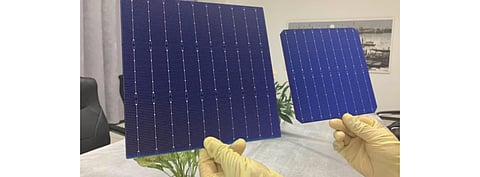

GS-Solar, a Chinese solar cell and module maker that turned into an equipment supplier, claims to have reached 25.2% power conversion efficiency for its mass production ready heterojunction (HJT) solar cells, with German certification and testing agency TÜV Nord certifying the efficiency.
GS-Solar calls this the highest efficiency for mass production technology HJT cells surpassing the previous record level 25.11% achieved by Hanergy, that has ceased its HJT related solar activities. A joint development program between French research center CEA-INES and HJT producer Enel Green Power attained a certified efficiency of 25% on M2 wafer size, which has been the highest certified efficiency reported for a full size HJT cell among today's active HJT players, according to our TaiyangNews Heterojunction Solar Technology 2020 report.
The company explained it was able to achieve this level of efficiency using a screen printing design and newly developed silver paste to allow for better conductivity and interconnection performance. Cost control has been achieved bringing the cost of producing a cell down by 8% to 12%, it adds, by greatly reducing silver paste consumption per cell to 120 mg.
Another reason that enabled the efficiency level of 25.2% was due to the improvement achieved in transmittance of the amorphous silicon film which can 'increase cell conversion efficiency by more than 0.2%'.
GS-Solar believes its use of new magnetron sputtering TCO materials and improved design of multi-layer transparent conductive films on mass production equipment can also boost current gains of more than 100 mA. It can also lead to efficiency level going up by more than 0.15%.
The Chinese company is hopeful that it will be able to take the conversion efficiency of its GW level HJT production line further up to between 26% to 30% with further technological enhancements. It did not provide details, but that would need tandem technology, such as used by Oxford PV (see Oxford PV Claims 29.52% Perovskite Solar Cell Efficiency)
Headquartered in China's Fujian province, GS-Solar uses home made core production equipment technologies of PECVD and PVD compatible with 166mm, 18xmm and 210mm silicon wafers.
Back in August 2020, the Chinese company launched a new module product at Shanghai based solar trade fair SNEC 2020 calling it the world's first polycrystalline HJT bifacial module with up to 23.5% efficiency (see China PV News Snippets: Seraphim, GS-Solar, SPIC).
In November 2020, GS-Solar entered an agreement with Zhoushan Municipal Government to build a 10 GW HJT solar cell production facility for RMB 8 billion (see China PV News Snippets: GS-Solar, JA, DZS, Trina, NDRC).
In December 2020, TaiyangNews launched our Heterojunction Solar Technology 2020 Edition with details on the latest on HJT technology which is available for free download here.
